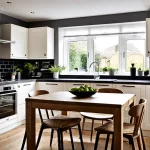Core advantages of galley layouts in slim UK kitchens
Galley kitchen layouts offer distinct galley kitchen benefits particularly suited to the spatial constraints typical of slim UK kitchens. Their design maximizes efficiency in limited space by positioning work surfaces and appliances directly opposite each other. This creates a compact triangle between the sink, stove, and refrigerator, which significantly enhances productivity during cooking tasks.
The streamlined workflow in narrow kitchen layouts reduces unnecessary movement. Everything is within arm’s reach, allowing for swift transitions between food preparation, cooking, and cleaning. This accessibility is critical in small kitchen efficiency, as it minimizes wasted steps, making meal preparation faster and less tiring.
Also read : Top layout ideas to maximize your slender uk kitchen space
Moreover, galley kitchens adapt exceptionally well to the usual dimensions seen in UK homes, where width is often limited but length is available. Their linear arrangement allows for effective use of vertical storage, increasing overall kitchen capacity without expanding the footprint. This adaptability ensures galley layouts can accommodate modern appliances and storage solutions while maintaining an open feel in confined spaces.
In summary, the galley kitchen benefits revolve around their ability to maximize small kitchen efficiency with a streamlined, practical design perfectly tailored to narrow kitchen layouts commonly found across UK properties.
In the same genre : Transforming a narrow uk kitchen: tips for crafting a practical dining space
Enhancing space and storage solutions
Maximising kitchen storage solutions in the UK often requires innovative approaches tailored to small space organisation. Vertical storage improvements are a crucial strategy. By utilising wall-mounted shelves, tall cabinets, and overhead racks, homeowners can significantly increase storage without expanding the kitchen footprint. This approach is especially effective in compact British kitchens, where every inch counts.
Optimising cabinetry is also key. Integrated appliances, such as built-in ovens and refrigerators, free up countertop and floor space, allowing for more efficient storage layouts. Custom cabinetry with pull-out shelves or corner carousel units helps tackle awkward spaces that frequently challenge UK kitchen storage efforts. These designs improve accessibility while maximising space utilisation.
Common storage issues in British homes often stem from limited room size and irregular kitchen shapes. Solutions include modular storage units that can be configured to fit specific areas and clever use of cupboard doors with internal racks or hooks. These enhancements directly address small space organisation concerns, making kitchens more functional and less cluttered.
Practical design tips for galley kitchens
Smart strategies to optimize narrow kitchen spaces
Designing a galley kitchen demands thoughtful kitchen layout planning to make the most of limited space while maintaining functionality. One effective galley kitchen design idea is to enhance visual space through the use of light colors and reflective finishes. Pale cabinets paired with glossy countertops create a sense of openness. Incorporating under-cabinet LED lighting brightens work surfaces, making the narrow area feel less cramped and more inviting.
When approaching a slim kitchen renovation, choosing finishes that amplify natural and artificial light is key. Consider minimalist hardware and handleless cupboards to reduce visual clutter. Mirrors or glass cabinet doors also help bounce light and add depth. Bright, even lighting along the length of the kitchen prevents shadowy corners, improving safety and functionality.
Traffic flow is crucial in a galley kitchen. Kitchen layout planning should prioritize clear pathways by locating appliances and sinks on opposite walls to avoid bottlenecks. For example, placing the refrigerator near the entrance allows quick access without interrupting cooking zones. Keeping countertops free of obstacles creates smooth movement and efficient meal preparation. Integrating pull-out storage solutions maximizes space without impeding flow, ideal for slim kitchen renovation projects aiming to combine style with practical daily use.
By balancing finishes, lighting, and layout, you can transform even the narrowest galley kitchen into a bright, efficient, and comfortable culinary space.
Galley kitchen comparison with alternative layouts
When considering kitchen layout options UK, the galley kitchen stands out for its efficiency, especially in smaller spaces. In a galley vs L-shaped kitchen comparison, the galley design optimizes workspace by placing cabinets and appliances along two parallel walls, allowing for easy movement and streamlined cooking processes. This layout minimizes walking distance between key areas, ideal for busy households.
While L-shaped kitchens provide more open space and flexibility, they often require larger areas and might not be the best fit for tight UK renovation scenarios. Conversely, galley kitchens maximize every inch, an advantage in many UK homes where space constraints dictate kitchen design. U-shaped kitchens offer extensive counter space, but they can feel cramped without sufficient room to move—making the galley layout preferable in compact settings.
Realistic case studies demonstrate how galley kitchens have successfully transformed small flats and terraced houses across the UK. Designers often enhance these layouts with clever storage solutions and bright finishes, ensuring the space feels functional and inviting without compromising style. For homeowners weighing small kitchen comparison options, understanding these practical strengths helps inform a choice that suits both lifestyle and property limitations.
Overcoming renovation challenges in British homes
Insights for practical and stylish kitchen transformations
Navigating UK kitchen renovation challenges requires addressing the unique quirks of British homes, especially period properties. Many older homes face restrictions due to listed status or conservation rules. This means homeowners must work within tight constraints to preserve original features while upgrading functionality. Creative solutions for awkward spaces—like narrow corridors or irregular room shapes—are crucial. Custom cabinetry or tailored layouts can maximize every inch without compromising on style.
One common challenge is integrating modern amenities in these older kitchens. Plumbing and electrical upgrades might be needed to accommodate new appliances or efficient heating. Installing smart kitchen technology must balance seamless integration and respect for the room’s character. Ensuring adequate ventilation and lighting further enhances usability without structural upheaval.
For those keen on small home remodel tips, focusing on cost-effective updates can deliver big returns. Consider:
- Replacing worn surfaces with durable, easy-to-clean materials like quartz or laminate.
- Updating cabinet fronts and hardware to refresh the look without full replacements.
- Adding open shelving for a sense of space and display options.
These practical kitchen improvements are accessible for most budgets and elevate everyday living. Understanding how to overcome renovation challenges in British homes empowers homeowners to blend heritage charm with contemporary conveniences.

